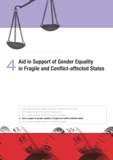Gender and development
Aid in Support of Gender Equality in Fragile and Conflict-affected States - Chapter 4
|
|||||
Main findings
Related links
|
Aid targeting gender equality in fragile states34% of total bilateral aid to fragile states targeted gender equality as a principal or significant objective. This is equivalent to USD 4.4 billion per year in 2007-08. 66% of the aid screened against the gender equality policy marker did not target gender equality. |
|
Related Documents
